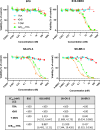Modeling antibody drug conjugate potential using a granzyme B antibody fusion protein
- PMID: 38486229
- PMCID: PMC10941411
- DOI: 10.1186/s12915-024-01860-x
Modeling antibody drug conjugate potential using a granzyme B antibody fusion protein
Abstract
Background: Antibody drug conjugates (ADCs) constitute a promising class of targeted anti-tumor therapeutics that harness the selectivity of monoclonal antibodies with the potency of cytotoxic drugs. ADC development is best suited to initially screening antibody candidates for desired properties that potentiate target cell cytotoxicity. However, validating and producing an optimally designed ADC requires expertise and resources not readily available to certain laboratories.
Results: In this study, we propose a novel approach to help streamline the identification of potential ADC candidates by utilizing a granzyme B (GrB)-based antibody fusion protein (AFP) for preliminary screening. GrB is a non-immunogenic serine protease expressed by immune effector cells such as CD8 + T cells that induces apoptotic activity and can be leveraged for targeted cell killing.
Conclusions: Our innovative model allows critical antibody parameters (including target cell binding, internalization, and cytotoxic potential) to be more reliably evaluated in vitro through the creation of an ADC surrogate. Successful incorporation of this AFP could also significantly expand and enhance ADC development pre-clinically, ultimately leading to the accelerated translation of ADC therapies for patients.
Keywords: Antibody drug conjugate; Antibody fusion protein; Granzyme B.
© 2024. The Author(s).
Conflict of interest statement
The authors declare that they have no competing interests.
Figures




Similar articles
-
The cytotoxic conjugate of highly internalizing tetravalent antibody for targeting FGFR1-overproducing cancer cells.Mol Med. 2021 May 7;27(1):46. doi: 10.1186/s10020-021-00306-2. Mol Med. 2021. PMID: 33962559 Free PMC article.
-
Development and Properties of Valine-Alanine based Antibody-Drug Conjugates with Monomethyl Auristatin E as the Potent Payload.Int J Mol Sci. 2017 Aug 25;18(9):1860. doi: 10.3390/ijms18091860. Int J Mol Sci. 2017. PMID: 28841157 Free PMC article.
-
Impact of Drug Conjugation and Loading on Target Antigen Binding and Cytotoxicity in Cysteine Antibody-Drug Conjugates.Mol Pharm. 2021 Mar 1;18(3):889-897. doi: 10.1021/acs.molpharmaceut.0c00873. Epub 2021 Jan 20. Mol Pharm. 2021. PMID: 33470823
-
Antibody-drug conjugates: Resurgent anticancer agents with multi-targeted therapeutic potential.Pharmacol Ther. 2022 Aug;236:108106. doi: 10.1016/j.pharmthera.2021.108106. Epub 2022 Jan 4. Pharmacol Ther. 2022. PMID: 34990642 Review.
-
Extracellular vesicles as modifiers of antibody-drug conjugate efficacy.J Extracell Vesicles. 2021 Feb;10(4):e12070. doi: 10.1002/jev2.12070. Epub 2021 Feb 13. J Extracell Vesicles. 2021. PMID: 33613875 Free PMC article. Review.
Cited by
-
Development of ZHPV16E7- granzyme B immunoaffitoxin: dual mechanisms targeting hpv16-positive cervical cancer through epithelial-mesenchymal transition inhibition and cell death.Front Immunol. 2025 Jul 21;16:1616715. doi: 10.3389/fimmu.2025.1616715. eCollection 2025. Front Immunol. 2025. PMID: 40761801 Free PMC article.
References
MeSH terms
Substances
Grants and funding
LinkOut - more resources
Full Text Sources
Research Materials

